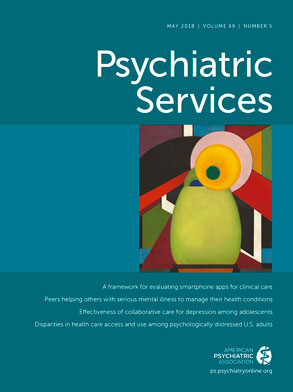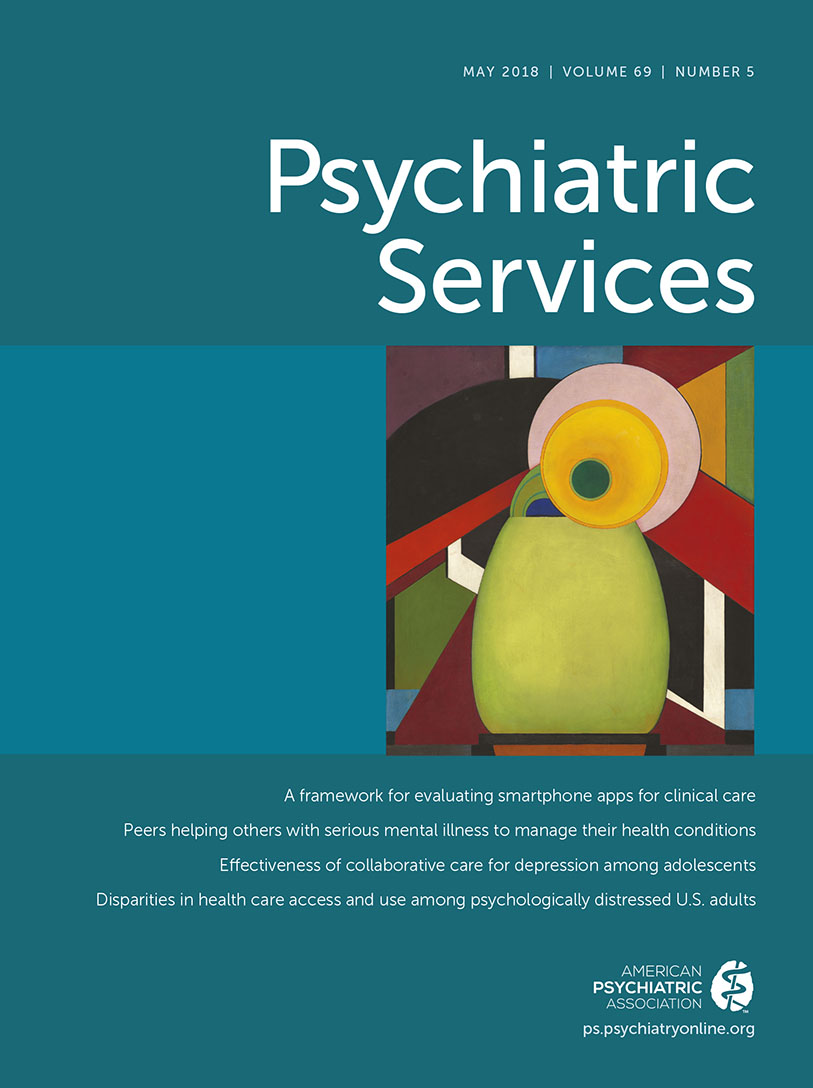The literature suggests that most people with new-onset severe mental illnesses and addictive disorders receive no treatment in any given year (
1,
2), and for those who eventually do, the average duration of untreated illness is excessive—that is, more than one year for psychosis (
3), three to eight years for mood disorders, and four to 23 years for anxiety disorders (
4). These findings are alarming in light of the links reported between longer duration of untreated conditions and poorer treatment outcomes (
5). Clearly, strategies to improve public mental health should directly address increasing access to care and shortening the duration of untreated illness.
Technology provides an unparalleled opportunity to reduce barriers to accessing secondary prevention and treatment services by reaching people far earlier in the course of illness and promoting early engagement with services that meet their needs—while reducing health disparities among vulnerable populations. To outline an approach to advancing research and disseminating evidence on the role of technology in this domain, stakeholders from academia, medical research institutes, health systems, federal agencies, advocacy groups, insurance companies, pharmaceutical companies, high-tech firms, and people with lived experience (69 participants and 47 organizations) gathered in New York City on October 13–14, 2016, for the Technology for Early Awareness of Addiction and Mental Illness (TEAAM-I) meeting.
Here we discuss three key issues raised by the TEAAM-I meeting work groups that are related to identified opportunities for technology to advance early identification, increase service engagement, and decrease the duration of untreated mental and addictive disorders. [An online supplement to this report includes details about the agenda, participants, and methodology and a summary of key areas for future research discussed in the meeting.]
We do not know the effect of online information on people’s engagement with mental health care.
The literature suggests that the Internet provides a comfortable setting for people to gather information about mental illness and addiction (
6) and may be also acceptable to vulnerable populations (for example, racial-ethnic minority groups) when specifically designed to meet their needs (
7). However, little is known about the context in which users seek online information related to mental illness and addiction and how these information-seeking behaviors affect individuals’ pathways to care.
For example, online screening programs, which provide users with information about the symptoms that they are experiencing (often via self-administered rating scales), may raise users’ awareness of their own or their loved-ones’ current state; however, it is not clear how those who screen positive (that is, report moderate or severe symptoms) use this information to engage with therapeutic interventions (
8). Mental Health America’s screening tool (
9), for instance, was launched in May 2014, and more than 1.5 million mental illness screens had been performed by the summer of 2016. About half of users who screened positive and who also responded to an online survey reported they were looking only for additional information or online tools, and most responded that they were not looking for referral to traditional treatment. Survey data did not include information about their help-seeking behaviors after completion of the online screening [see
online supplement].
To address this issue, the connections between user characteristics and a range of factors must be examined. There is a need to explore both the preventive potential of online information and how such information promotes early engagement with traditional and nontraditional cost-effective care. Research should focus on the characteristics and background (collected both online and in person) of users exposed to online information and follow them over a substantial period to shed light on such online interventions’ effect on pathways to care.
We have to target users’ own conceptualization of needs to best engage them at an early stage.
Here we refer to online services aimed at preventing or treating people who are aware of something that bothers them—that is, being in need. The definition or threshold of what constitutes “being in need” depends substantially on one’s perspective—for example, a person experiencing distress, a significant other, a provider, a payer, or a policy maker. In the traditional health care system, individuals come to a clinical setting and are examined through the lens of symptoms and diagnosis, allowing providers and payers to determine treatment options. In this way, the current diagnostic system strongly influences the system’s conceptualization of needs.
Part of the promise of technology is that it is accessible in more personal settings long before a person may seek treatment in a clinical setting. For example, most people accessing a national online mental health service reported that they were not currently in contact with mental health services (
10). In addition, findings from the World Health Organization and National Comorbidity Survey Replication indicate that many people with diagnosed disorders have a low perceived need for treatment or prefer to self-manage their symptoms (
11,
12). This population, which may be the largest potential group of mental health care consumers, has never been accessible for intervention through traditional face-to-face venues, and addressing their needs may offer an enormous potential to affect mental health at a population level. The promise of technology in helping these individuals is evident from a recent study indicating that up to 80% of persons who registered to use an online mental health service were not concurrently using traditional mental health care (
10). Although technology has the potential to engage individuals at an earlier stage of need, we have little understanding of their own conceptualizations of such needs.
To address this issue, models should be developed that clarify individuals’ own conceptualization of needs at early stages to guide the development of novel and successful online services. Development and validation of models that can identify and classify different groups of people could be a first step in structuring novel, tailored interventions to address specific needs within these groups. For example, a risk stratification model could take into consideration the individual’s perceived areas of need and level of distress, the severity of symptoms and potential harm to self or others, readiness to change or engage with treatment, external stressors (for example, finances and family conflict), and the possible risks of identifying someone as potentially ill when he or she is not versus the risks of leaving an ill person untreated.
People use technologies in the context of their lives to meet their own needs and goals and not the goals of others, no matter how well intentioned they are. However, digital, evidence-based interventions are often narrowly skewed toward addressing specific signs and symptoms of mental illnesses, and an individual’s perception of needs and functional goals are often inadequately addressed. Developing evidence-based solutions that include functional recovery as a goal could be more sensitive to the way that people conceptualize their problems and needs and help increase engagement with appropriate services.
Illness identification is different than monitoring those already diagnosed as having mental illness.
In recent years, there has been an enormous increase in programs developed to enable the proactive identification of the signs and symptoms of mental and addictive disorders by using passive data and digital signatures. The underlying assumption is that raw data (for example, patterns of movement, sleep, speech, and heart rate) may be related to mental states and may eventually predict symptom exacerbation and the occurrence of acute mental illness (
13). Overall, because recorded digital footprints and signatures can vary greatly among individuals (
14), predictions of mental states are likely to be most fruitful when focused on individual changes over time rather than only on patterns relative to group norms.
Using digital signatures to identify individuals potentially in need of treatment prior to their engagement with traditional mental health care presents several challenges. First, research has yet to demonstrate the feasibility of convincing “healthy” individuals to monitor their mental health. Second, proactive identification of incipient illness among those experiencing a first episode of mental illness does not allow for possible comparison with a previous event experienced by the same person that could serve as an indicator.
To address this issue, the feasibility and acceptability of self-monitoring interventions for populations not seeking treatment should be investigated. Rather than targeting the identification of psychiatric illness, another possible approach could target general well-being or could engage individuals in structured environments, such as primary care clinics. One suggested way to deal with the absence of indicators of a previous event involves implementing an initiative similar to the Human Genome Project (
15) to gather large amounts of behavioral data to enable identification of typical patterns of change (from being “healthy” to being “ill”). Potential concerns about privacy and the importance of being transparent with users about the data being collected need to be addressed.
In conclusion, technology provides an unprecedented opportunity to engage people outside traditional health care settings and far earlier in the course of illness. Capitalizing on this opportunity, however, requires stakeholders to challenge underlying assumptions about traditional pathways to mental health and addiction care. Collaborative meetings such as the TEAAM-I can facilitate an active network of stakeholders to identify gaps in knowledge, address these challenges, and promote pragmatic goals and priorities for research and practice, funding, and implementation efforts.

